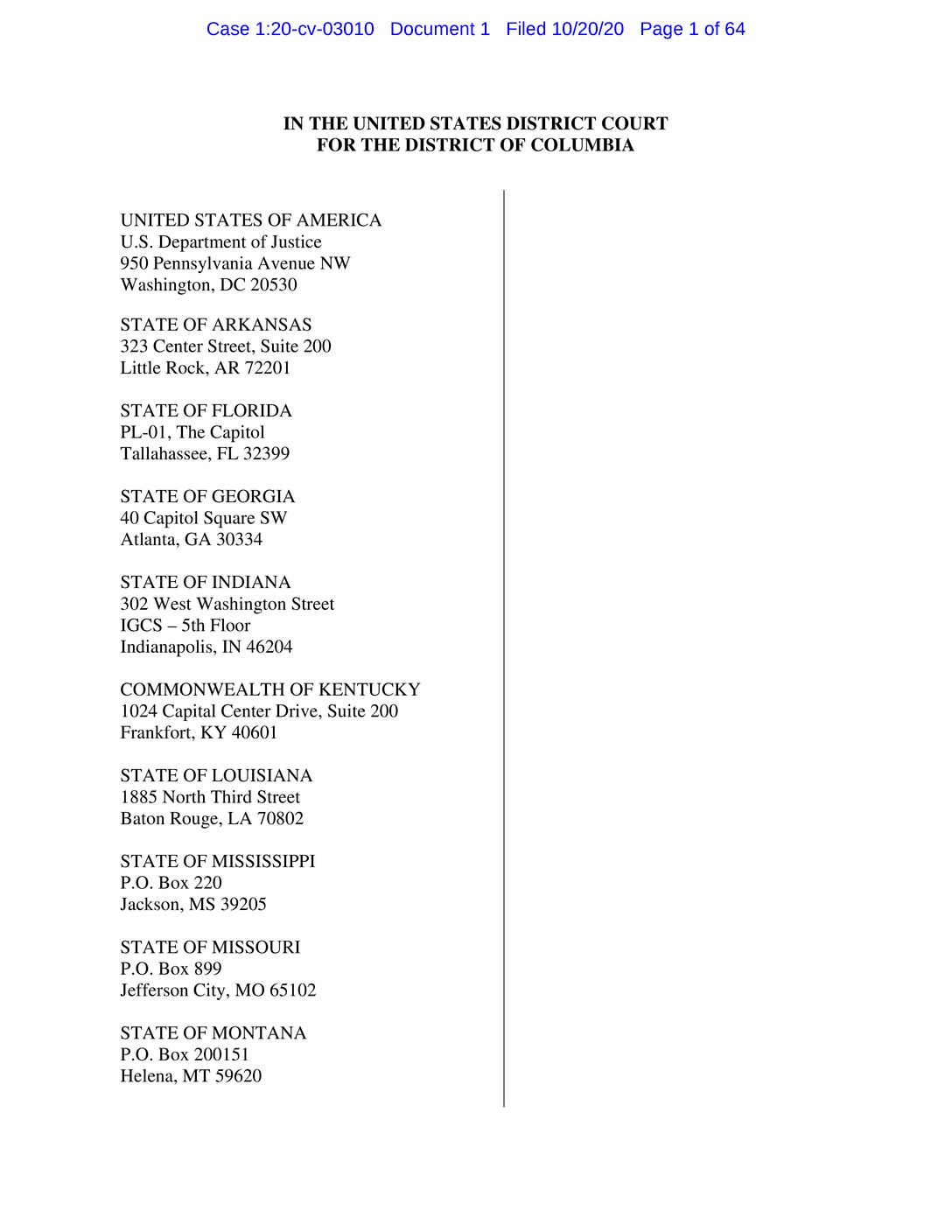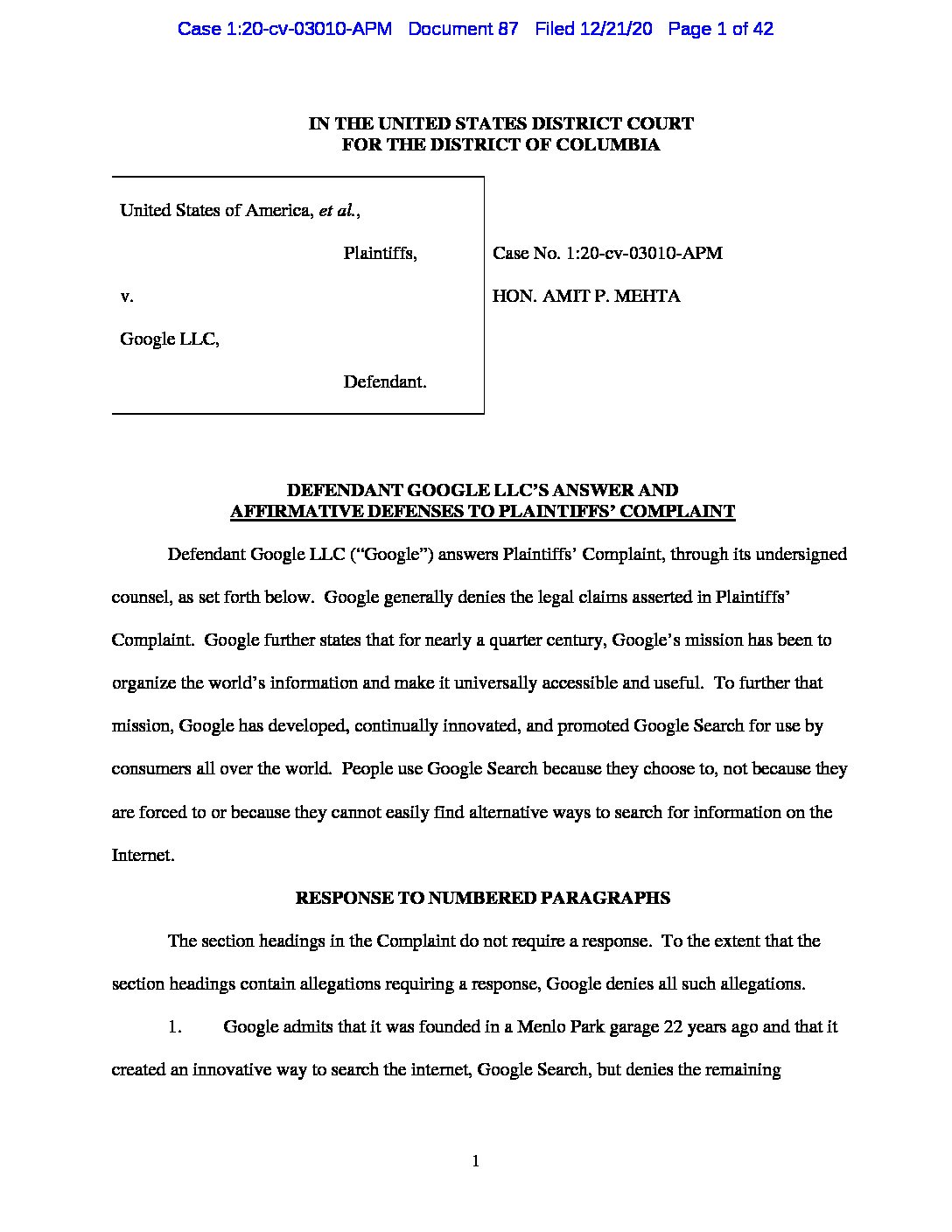Home › Forums › Litigation Discussion › U.S. vs. Google antitrust: what’s Google’s [P]lay?
- This topic has 0 replies, 1 voice, and was last updated February 28, 2021 at 10:40 pm by
 FPS.
FPS.
-
AuthorPosts
-
February 28, 2021 at 10:40 PM #1379
Case: United States, et al. v. Google, LLC, 1:20-cv-03010 filed on 10/20/20
Court: U.S. District Court for the District of Columbia
Judge: Amit Mehta
As many of you may be aware, the United States along with several individual states recently sued Google under section 2 of the Sherman Act (15 U.S.C. §2) based upon alleged monopolization for general search, search advertising and general search text advertising. Please note that this thread refers only to the first of three antitrust lawsuits filed against Google since October, 2020. Copies of the complaint and Google’s answer are attached for those interested. A rather striking disparity between the pleadings becomes immediately apparent; whereas the complaint is hyper-detailed and appears to be the result of significant research into Google’s business practices, the answer seems perfunctory, and perhaps purposely so. But Google’s affirmative defenses leave much to the imagination and certainly lack the factual precision of the Plaintiffs’ allegations.
The purpose of this thread is to examine potential strategies that Google may have to effectively defend against this litigation. Let me begin by acknowledging that I am not an antitrust lawyer, and I would therefore welcome insight from anyone with practical experience in this area (or, for that matter, anyone else with an interest in the case regardless of practical experience). I will also point out that although I am a fan of Google’s products and services, I tend to agree with the Plaintiffs’ contention that the company is indeed a monopoly which harms consumers. Sure, Google’s search engine (along with its open-source Android mobile operating system and Chrome web browser) is offered to the public free of charge – which is likely one of various reasons why Google is synonymous with search. But that accessibility and ubiquity enables Google to dominate online advertising. As the Plaintiffs aptly point out in the complaint (see p.11, the “consumer purchase funnel”), search advertising is incredibly valuable to merchants because the ads are displayed at the moment a potential consumer is expressing interest in a subject by entering related search terms. A Google search is often the final step taken by a consumer before a particular product or service is purchased. Thus, Google’s inarguable search dominance enables it to dictate the cost of advertising on its platform above a level which might prevail in a more competitive environment. Consumers ultimately foot the bill for Google’s monopolistic search advertising prices as advertisers pass the higher costs along.
One element of the Plaintiffs’ burden here will be to prove Google’s possession of monopoly power. See U.S. v. Microsoft Corp., 253 F.3d 34, 50 (D.C.Cir.2001) (“The offense of monopolization [under section 2 of the Sherman Act] has two elements: ‘(1) the possession of monopoly power in the relevant market and (2) the willful acquisition or maintenance of that power as distinguished from growth or development as a consequence of a superior product, business acumen, or historic accident.’” (citing United States v. Grinnell Corp., 384 U.S. 563, 570-71, 86 S.Ct. 1698, 16 L.Ed.2d 778 (1966)). If the Court agrees that search advertising (and general search text advertising) are relevant markets, Plaintiffs will satisfy their burden to prove that Google has monopoly power in those markets by establishing the existence of barriers to entry which insulate Google from competition. Id. at 51 (“monopoly power may be inferred from a firm’s possession of a dominant share of a relevant market that is protected by entry barriers” (citing Rebel Oil Co. v. Atl. Richfield Co., 51 F.3d 1421, 1434 (9th Cir.1995)).
The complaint makes clear that Google’s suite of exclusionary agreements with device manufacturers and browser developers – while also forming the basis of Google’s alleged unlawful maintenance of its monopoly power (i.e., the 2nd element required to establish a §2 violation) – simultaneously act as significant barriers to entry. See complaint ¶¶95, 110 (discussing the importance of scale and how Google’s anticompetitive conduct denies scale to any would-be rivals). In other words, the MADAs, RSAs and other agreements described in the complaint enable Google to exclude competitors from occupying default status on mobile devices, browsers and even IoT devices. That default status – which Google pays billions for annually – ensures that potential rivals never achieve the critical mass needed to attract advertisers.
So why is this bad for Google? Are they not innocuously paying the supermarket for prime shelf space much like a cereal brand would do (see https://blog.google/outreach-initiatives/public-policy/response-doj)? If the allegations of the complaint are accurate, the “supermarket shelf space” analogy falls a little flat. Specifically, the Plaintiffs are alleging: a) the majority of internet searches are performed via mobile platforms (complaint¶42); b) Google enjoys preset default status “for an overwhelming share” of U.S. mobile device search access points (complaint ¶45); and c) Google’s suite of exclusionary agreements in many cases expressly preclude mobile device manufacturers from installing rival search apps or replacing Google as the default search option (complaint ¶56). Moreover, Google over the last 15 years or so has made a calculated play to dominate search on mobile devices via the acquisition, development and licensing of the Android mobile operating system (complaint ¶¶58-77). Along with Android, Google licenses its suite of industry-leading apps (YouTube, Google Play store, etc.) and enters into lucrative revenue sharing agreements – all of which is dependent upon Android device manufacturers agreeing to make Google the default search option (complaint ¶¶76, 78).
Rather than a cereal brand paying the supermarket for prime shelf placement, what Google is actually doing is more akin to the cereal brand cementing its market dominance by manufacturing the shelving itself, and then licensing the shelving to the supermarket on the condition that only the dominant cereal brand can be displayed (but if the consumer wants to rearrange the shelving to display other brands, they are welcome to do so). More to the point, Google’s practices in this regard appear to have long since been condemned under the Sherman Act. See, e.g., Microsoft Corp., 253 F.3d at 61 (“As noted above, the OEM channel is one of the two primary channels for distribution of browsers. By preventing OEMs from removing visible means of user access to IE, the license restriction prevents many OEMs from pre-installing a rival browser and, therefore, protects Microsoft’s monopoly from the competition that middleware might otherwise present. Therefore, we conclude that the license restriction at issue is anticompetitive”); and 62 (“This kind of promotion is not a zero-sum game; but for the restrictions in their licenses to use Windows, OEMs could promote multiple IAPs and browsers. By preventing the OEMs from doing so, this type of license restriction, like the first two restrictions, is anticompetitive: Microsoft reduced rival browsers’ usage share not by improving its own product but, rather, by preventing OEMs from taking actions that could increase rivals’ share of usage.”)
In other words, Microsoft violated the Sherman Act by imposing Windows license restrictions which impeded device manufacturers from installing rival browsers – much like Google is accused of doing with respect to its Android licensing and default search status. Because Google’s exclusionary agreements are designed to forestall potential rivals from developing the necessary scale to become competitive (and to the extent the agreements are effective in doing so), these practices will likely be deemed anticompetitive.
Does Google have any viable defenses here? If the facts as alleged in the complaint are accurate, I’m not seeing many options. But a careful review of the Microsoft decision reveals at least one potential avenue. Specifically, Microsoft rather creatively argued both at trial and on appeal that the District Court’s analysis of the relevant market was flawed because it failed to account for emerging threats to Microsoft’s dominance of the desktop PC operating system market. See id. at 52 (Microsoft criticizes the District Court’s market definition as “far too narrow” because it ignores, among other potential threats, “operating systems for non-PC devices”); see also id. at 57 (“The District Court expressly considered and rejected Microsoft’s claims that innovations such as handheld devices … would soon expand the relevant market beyond Intel-compatible PC operating systems.”)
The Circuit Court summarily dismissed these points due to Microsoft’s failure to cite supporting record evidence or to argue that the District Court’s factual findings to the contrary were clearly erroneous. See id. at 52 (“[Microsoft] fails to challenge the District Court’s factual findings, or to argue that these findings do not support the court’s conclusions.”) Ironically, however, history may have proven Microsoft correct. Just about six years after the Microsoft decision was issued, Apple released the iPhone in 2007. I would argue that this event marked the end of Microsoft’s operating system dominance by virtue of the iPhone’s functionality encompassing much, if not all, of what was previously available only via desktop computer. And of course, the release of the iPhone ushered in the smartphone era in general whereby such devices packed in so much functionality that they were rightly considered handheld computers. Consumers no longer had a need to rely primarily upon Windows to browse the web, send and receive email or do their online banking. And I would go so far as to say it would be difficult to argue that Microsoft’s current success has much to do with Windows anymore; although Windows may still dominate the desktop market, the desktop market has been eclipsed by handheld devices. Microsoft has continued to succeed due to its nimbleness. As a result, it’s unclear whether, in retrospect, the government’s antitrust litigation against the company achieved anything more than what naturally occurred due to the advent of smartphones.
I would therefore argue that if Google can adduce some compelling record evidence of emerging technology which will threaten its search dominance, it may succeed where Microsoft failed. It needs to establish that, just as smartphones dethroned desktop computers (and Windows) as the dominant means of internet access, some new technology will imminently shift the paradigm away from Google’s search monopoly and thereby eliminate much of its current market power.
Not an easy argument to make, but then again Google’s defensive options appear limited. But this is just my take – I invite anyone and everyone to point out any errors in my reasoning or anything I may have overlooked. Thanks for reading!
-
AuthorPosts
- You must be logged in to reply to this topic.

